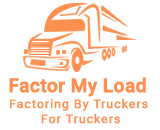1. Submission of Invoices: The process begins with a trucking company delivering its goods or services and issuing client invoices. These invoices represent the amount the client owes to the trucking company.
3. Invoice Verification: Once the factoring company receives the application, they will evaluate the invoices. They check the creditworthiness of the trucking company’s clients and the authenticity of the invoices.
4. Funding: Upon approval, the factoring company provides a cash advance to the trucking company, typically covering a significant percentage of the invoice amount, often around 80-95%.
5. Client Payment: The factoring company is responsible for collecting payments from the trucking company’s clients. Clients will pay the factoring company rather than the trucking company.
6. Reserve Release: The factoring business releases the balance to the trucking company after the customer pays the invoice in full, less their charge. This is referred to as the reserve release.
1. Improved Cash Flow: The instant cash infusion into the trucking company’s operations is one of the factoring’s most important benefits.
This enables businesses to cover expenses such as fuel, maintenance, and payroll without delay.
2. Steady Working Capital: Trucking companies can better plan and manage their day-to-day operations with consistent cash flow. They can take on more jobs, expand their fleets, and seize growth opportunities.
3. Reduced Administrative Burden: Factoring companies handle the time-consuming task of invoice collection and credit checks. This frees up the trucking company’s resources, allowing them to focus on core business activities.
4. Flexibility: Factoring agreements are adaptable and can be adapted to the needs of the trucking firm.
Whether it’s occasional use or ongoing factoring, there’s an option for everyone.
5. Access to Expertise: Factoring companies often have deep industry knowledge and can provide valuable insights and support to their clients.
6. No Debt Incurred: Factoring is not a loan, which means there’s no debt to repay. Trucking companies receive cash against their invoices, not a loan that accumulates interest.
Now, let’s take a closer look at the various stages involved in the factoring process:
1. Application and Approval: As mentioned earlier, the process begins with the trucking company applying to a factoring company. The approval process typically involves a review of the company’s financial health and the creditworthiness of its clients.
2. Rate and Terms Negotiation: Once approved, the trucking company and the factoring company negotiate the terms of the agreement, including the discount rate (the percentage of the invoice amount that the factoring company charges as its fee) and any additional fees.
3. Due Diligence: The factoring company conducts due diligence, which may include background checks on the trucking company and its clients and a review of the submitted invoices.
4. Advances: The factoring business pays the trucking firm a portion of the invoice amount following a positive outcome of the due diligence.
This advance typically ranges from 80% to 95% of the invoice value.
6. Client Verification: The factoring company verifies the authenticity of the invoices and conducts credit checks on the clients to assess their ability to pay.
7. Payment Collection: The factoring company communicates with the trucking company’s clients to collect payments. Clients make payments to the factoring provider directly.
8. Reserve Release: Once the client pays the invoice in full, the factoring company releases the remaining balance to the trucking company, minus their fees.
9. Ongoing Support: Throughout the factoring arrangement, the factoring company provides ongoing support, including detailed reporting, to the trucking company. This helps the trucking company keep track of their finances and plan effectively.
In a highly competitive industry where timing is crucial, factoring in trucking can be the key to success. It streamlines cash flow and reduces the administrative burden of invoice management and client collections, allowing trucking companies to focus on what they do best: delivering goods efficiently and on time.

